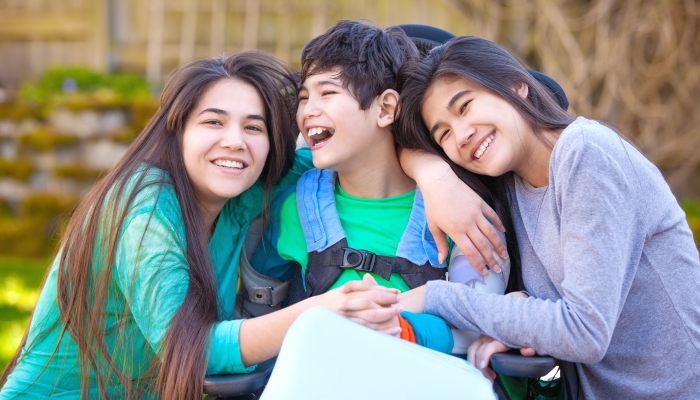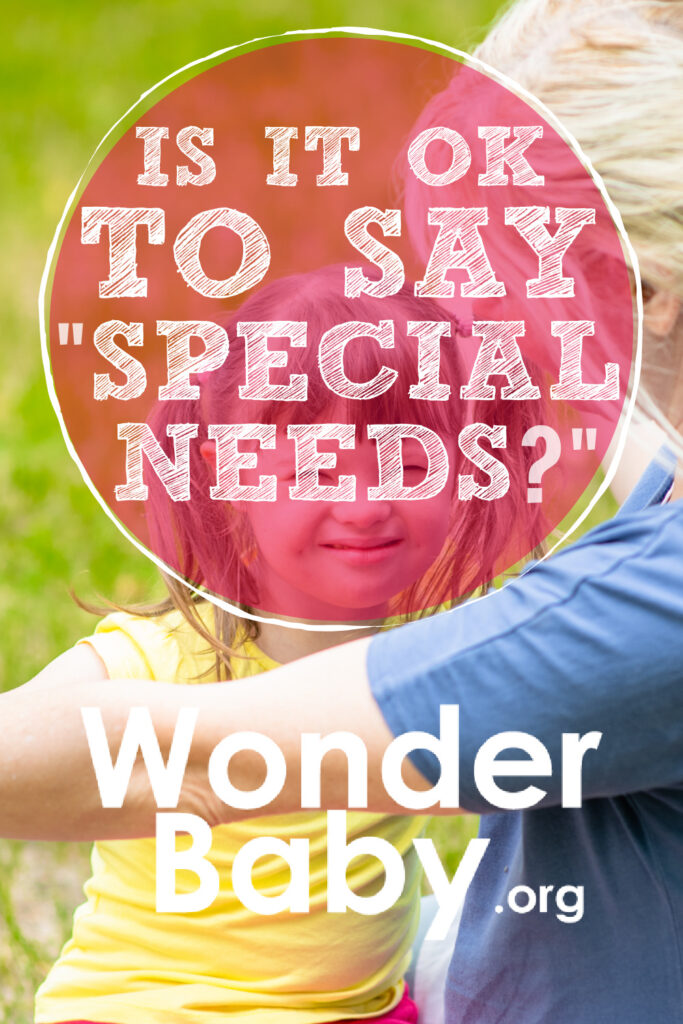Is It OK To Say “Special Needs?”

- The term “special needs” has become outdated and is often deemed inappropriate as a way to refer to someone with a disability.
- Instead of referring to someone as a “disabled person,” you can say “a person with disabilities.”
- There are several alternatives to using the term special needs that identify the person first and then the disability.
There are well-known words we teach our children not to say. We all know them. You know, that bad word you shouldn’t have said when you were seven? Yep, that one.
However, some words ride the line of whether we should use them or not, especially since they don’t apply to the general population. How do we know if it’s offensive if it doesn’t hurt our feelings?
I remember hearing, “Sticks and stones may break my bones, but words can never hurt me,” as a kid. There’s nothing further from the truth; words have a lasting memory on a person.
Which brings us to this question—is it OK to say “special needs?” It’s a touchy subject, I made myself very aware of while researching this topic. It’s always easy to have an opinion when you’re on the other side.
While there’s plenty of research on the topic, remember always to value the opinions of those in the thick of it. The individuals who know firsthand what it’s like to be looked at differently because of something out of their control.
The Debate Around the Phrase “Special Needs”
As with everything in society, there’s debate on whether referring to someone as having special needs is an issue. It’s difficult to know who’s “right,” but looking at both sides is essential.

Arguments for the Phrase
You’ll find plenty of debate on whether the word disabled or the word disability is considered offensive. However, is it up to us to decide?
I didn’t find much research that was pro “special needs.” Most people steer towards political correctness and respecting a person’s wishes on what they prefer.
However, some view the term to emphasize the unique requirements and support individuals with disabilities may have.
Arguments Against the Phrase
Many people in the general population feel uncomfortable using the term disability or disabled.
However, when you shy away from using specific terms, it’s promoting the idea that someone with a disability should be ashamed.
In addition, the National Education Association11. Words Matter! Disability Language Etiquette. National Education Association. https://www.nea.org/words-matter-disability-language-etiquette (NEA) considers euphemisms like “differently abled,” “challenged,” and “handi-capable” to be condescending and argues that they should be avoided.
The NEA also puts the word “special” in this grouping because of its “paternalistic nature” and recommends using the words “disabled” or “disability.” The term “special needs” is not recommended by disability advocates as a term you should use.
Alternative Terms and Phrases

The fundamental principles of disability language etiquette include person-first and identity-first language. The various terms and phrases will likely have you second-guessing saying “disabled person” or “disabled people.”
While you likely won’t come out and ask someone directly how they want to be addressed, it’s essential to take their cues and follow accordingly.
Person-First Language
Some prefer person-first language because it sees the person first and then the disability. For example, instead of saying “disabled people,” person-first language would be “people with disabilities.”
Another example would be to say “a child with Down Syndrome.” In both instances, you identify the individual before a person’s disability. While it may not mean much difference for you, it could mean the world to the child.
It’s frequently recommended for non-disabled people to use person-first language until told otherwise. Remember, the goal is to help reduce discrimination and stereotypes and emphasize a person’s individuality rather than their disability.
Identity-First Language
On the other hand, some people with disabilities prefer identity-first language, where you put their disability first. For example, you would say an “autistic person” or “disabled person.”
Some people prefer identity-first language22. Taboas, A., Doepke, K., & Zimmerman, C.. Preferences for identity-first versus person-first language in a US sample of autism stakeholders. Autism. 2022;27(2), 565–570. https://doi.org/10.1177/13623613221130845 because it embraces all aspects of one’s identity, and they find that person-first language is unconventional and draws attention to the disability.
Remember, it’s not always possible to know how a person would prefer to be introduced, but it is essential to respect their preference.
The Role of Self-Identification
As a parent, I strive to ensure my children are themselves and don’t worry about what others think. We live in a society with so much influence on our looks, behavior, wealth, etc., and it can be overwhelming for anyone.
I respect that people view themselves in a specific way, and it doesn’t take much for others to respect their self-identification.

Personal Preferences
As with most things in life, it’s up to the personal preference of a person how they should be referred. A person with a disability may not feel comfortable with you skirting around the subject of their wheelchair.
The bottom line is if it feels offensive to the other person, don’t say it. You don’t have to use special care when addressing a person with a disability; use respect.
Respect and Dignity in Language
While it’s important to respect a person’s personal preference, it’s best to avoid outdated and offensive terms like “handicapped” or “crippled.”
The Northwest ADA Center33. Respectful Interactions: Disability Language and Etiquette. Northwest ADA Center. https://nwadacenter.org/factsheet/respectful-interactions-disability-language-and-etiquette has a fantastic overview of generally discouraged and encouraged terms regarding a person with disabilities.
Examples of discouraged and encouraged terms include:
| Generally Discouraged Terms | Generally Encouraged Terms |
| Handicapped children | People with a disability |
| Able-bodied | Has a disability |
| Special needs | A person with a learning disability |
| Wheelchair user | People with intellectual disabilities |
| Brain damaged | People with brain injuries |
Legal and Policy Considerations
There’s a lot of history and legal considerations behind the term special needs, leading to where we are today. I always find it interesting to see where we began as a society and how much we’ve grown.

Terminology
In reality, “special needs” isn’t a legal term, and you won’t find it in a person’s medical record. While being disabled is part of human diversity, respecting those who fall into the category is important.
The Individuals with Disabilities Education Act44. About IDEA. U.S. Department of Education. https://sites.ed.gov/idea/about-idea/#:~:text=The%20Individuals%20with%20Disabilities%20Education,related%20services%20to%20those%20children. (IDEA) doesn’t use the term “special needs”; instead, it says “child with a disability.” What makes it a dirty word?
According to the National Center for Disability Journalism55. Gernsbacher, M. A., Raimond, A. R., Balinghasay, M. T., & Boston, J. S.. “Special needs” is an ineffective euphemism. Cognitive Research: Principles and Implications. 2016;1(1). https://doi.org/10.1186/s41235-016-0025-4, “special needs” euphemistically stigmatizes people with disabilities. In other words, it conveys the notion that disabled people should be avoided or shamed.
Changing Norms in Official Language
In the past, the r-word was commonly used to describe a person with disabilities, and at the time was proper terminology. However, over time, it became derogatory, and the general population knows it’s no longer politically correct to use it.
In addition, the term special needs was used by the educational system, but wasn’t meant to refer to a disability. Before the 1960s, a family with a child with “special needs” had to fund their education privately66. The History of Special Education in the U.S. Arkansas State University Online. 2016. https://degree.astate.edu/online-programs/education/master-of-science/sped-k-12-instructional-specialist/the-history-of-special-education-in-the-u-s.
If a child had cognitive or emotional disabilities, blindness, deafness, or needed speech therapy, it was up to the parent to educate their child or send them to private school. They couldn’t attend public school. Could you imagine?
However, things changed when parents began creating advocacy groups for their children and met with teachers and politicians. By 1965, Lyndon B. Johnson started signing off on acts designed to expand public education and its funding purposes, helping pave the way for special needs advocacy.
Education Laws
In 1975, the Education for All Handicapped Children Act was put into law, stating all children should have access to free public school education regardless of their differences. Later, it was renamed the Disabilities Education Act of 2004.
In 2020–2021, more than 66% of children77. A History of the Individuals With Disabilities Education Act. U.S. Department of Education. 2023. https://sites.ed.gov/idea/IDEA-History with disabilities were in general education classrooms for 80% or more of their school day. In addition, early intervention services were provided to more than 360,000 infants and toddlers with disabilities and their families.
The FAPE mandate is another vital program ensuring all children with disabilities have access to a free public education.
Remember, this all started because a group of parents knew their children deserved an inclusive classroom.
Guidelines for Respectful Communication
It’s essential for parents to instill important values like respectful communication in their children so they know how to treat others in life.
One of the most important things we can teach our children is to treat others as we would want to be treated, regardless of their limitations.

Best Practices in Professional Settings
It’s important to remember that disabilities are part of the human experience and show our diversity. There’s no reason why a person in a professional setting should be treated differently because of their disability.
For example, if someone uses a wheelchair, ensure they have access to the same places as everyone else. If that’s not the case, don’t hesitate to speak up. Sometimes, it’s hard to be our own advocate, and the community should show support.
Etiquette in Social Interactions
If you’re in a social situation with individuals with disabilities, you shouldn’t treat them any differently. Communicate with the individuals the same way you would anyone else. You shouldn’t let a person’s disability get in the way of your interactions.
You may feel more comfortable around a person with disabilities if you grew up with someone who has a physical or intellectual disability.
The key is approaching conversations sensitively, actively listening to the individual, and being responsive to their preferences.
References
- Words Matter! Disability Language Etiquette. National Education Association. (n.d.). https://www.nea.org/words-matter-disability-language-etiquette
- Taboas, A., Doepke, K., & Zimmerman, C. (2022). Preferences for identity-first versus person-first language in a US sample of autism stakeholders. Autism, 27(2), 565–570. https://doi.org/10.1177/13623613221130845
- Respectful Interactions: Disability Language and Etiquette. Northwest ADA Center. (n.d.). https://nwadacenter.org/factsheet/respectful-interactions-disability-language-and-etiquette
- About IDEA. U.S. Department of Education. (n.d.). https://sites.ed.gov/idea/about-idea/#:~:text=The%20Individuals%20with%20Disabilities%20Education,related%20services%20to%20those%20children.
- Gernsbacher, M. A., Raimond, A. R., Balinghasay, M. T., & Boston, J. S. (2016). “Special needs” is an ineffective euphemism. Cognitive Research: Principles and Implications, 1(1). https://doi.org/10.1186/s41235-016-0025-4
- The History of Special Education in the U.S. Arkansas State University Online. (2016, July 14). https://degree.astate.edu/online-programs/education/master-of-science/sped-k-12-instructional-specialist/the-history-of-special-education-in-the-u-s
- A History of the Individuals With Disabilities Education Act. U.S. Department of Education. (2023, November 30). https://sites.ed.gov/idea/IDEA-History

Related Posts

Eye Conditions and Syndromes, Visual Impairment
Neuralink Announces Plans to Restore Sight to the Blind with Brain Chip
Elon Musk’s company Neuralink has announced plans to begin human trials of its new “Blindsight” brain chip by the end of 2025.

Special Needs
5 Spring Cleaning Tips for Families of Children with Disabilities
Spring cleaning is an opportunity to create a more accessible, organized, and supportive space for your child with disabilities. Declutter, deep clean, and refresh!

Visual Impairment
The Gift of Understanding: How a Young Child Helps His Blind Father Navigate Life
When a parent is blind, it’s natural for people to wonder how their sighted child will adapt. Will they struggle to understand their parent’s needs? Will they feel burdened by...